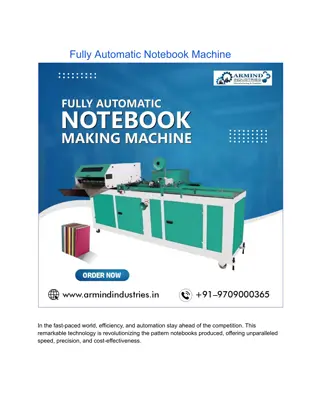Essential Guidelines for Keeping a Laboratory Notebook
Understanding the importance of maintaining a laboratory notebook is crucial in research settings. The notebook serves as a comprehensive record of procedures, reagents, data, and thoughts to be shared with fellow researchers. It also functions as a place to troubleshoot issues, compile data, and defend against accusations of fraud or lawsuits. Different types and formats of notebooks are available, with electronic notebooks offering added benefits like mobility, security, and tamper-proof storage.
Download Presentation

Please find below an Image/Link to download the presentation.
The content on the website is provided AS IS for your information and personal use only. It may not be sold, licensed, or shared on other websites without obtaining consent from the author.If you encounter any issues during the download, it is possible that the publisher has removed the file from their server.
You are allowed to download the files provided on this website for personal or commercial use, subject to the condition that they are used lawfully. All files are the property of their respective owners.
The content on the website is provided AS IS for your information and personal use only. It may not be sold, licensed, or shared on other websites without obtaining consent from the author.
E N D
Presentation Transcript
Keeping a Laboratory Notebook Gail P. Taylor Asst. Program Director UT San Antonio RISE/MARC-U*STAR programs
Acknowledgements Kathy Barker, At the Bench: A laboratory Navigator. Cold Spring Harbor Laboratory press. 1998. Guidelines for Keeping a Laboratory Record. David Caprette, Rice University. http://www.ruf.rice.edu/~bioslabs/tools/notebook/notebook.html Guidelines for Keeping a Laboratory Notebook. Colin Purrington, Swarthmore Univ. http://www.swarthmore.edu/NatSci/cpurrin1/notebookadvice.htm Laboratory Record Keeping. Todd E. Garabedian, Nature Biotechnology v. http://www.ruf.rice.edu/~bioslabs/tools/notebook/notebook.html http://www.swarthmore.edu/NatSci/cpurrin1/notebookadvice.htm http://biotech.about.com/gi/dynamic/offsite.htm?site=http%3A%2F%2Fwww.wiggin.com%2Fpubs%2Farticles_template.asp%3FID%3D102187242000 15 (August 1997) pp.799-800 http://biotech.about.com/gi/dynamic/offsite.htm?site=http%3A%2F%2Fwww.wiggin.com%2 Fpubs%2Farticles_template.asp%3FID%3D102187242000 Office of Research Integrity, U.S. Dept. of Health and Human Services http://www.unh.edu/rcr/ Responsible Conduct of Research Online Study Guide. Julie Simpson, University of New Hampshire http://www.unh.edu/rcr/ Francis L. Macrina, Scientific Integrity: An Introductory Text with Cases. ASM Press. 2000. http://biotech.about.com/gi/dynamic/offsite.htm?site=http%3A%2F%2Fwww.wiggin.com%2Fpubs%2Farticles_template.asp%3FID%3D102187242000 http://www.unh.edu/rcr/
What is a Lab Notebook? Complete record of procedures, reagents, data, and thoughts to pass on to other researchers Why experiments were initiated, how performed, and results, comments Place to compile data/charts/photos/ideas Place of clues, to troubleshoot problems Place to observe whole picture and think Legal document, to prove patents Defense against accusations of fraud or lawsuits
How Important? Very- Often has all original data in it
Type and Format Ultimately dictated by your PI/company Type Advantages Drawbacks Bound book (stitched) No lost sheets Proof against Fraud Entered as done No logical order Duplicate Bound Book (yellow sheets) Double record. Easy copies Diff. To Read. Not true duplicate Lost sheets Authenticity prob. Loose Leaf (folders/notebooks) Order by expts Easy recording Computer Easy to read Easy calculations Lost data Authenticity prob
Electronic Notebooks? ELN Electronic Lab Notebook LES Lab Executive System Pros and Cons Arise from Reading and Writing Mobility Security Storage Proof from tampering (how to prove w electronic) http://blog.labguru.com/blog-labguru/10-reasons-to-ditch-paper-and- switch-to-electronic-lab-notbooks http://www.the- scientist.com/?articles.view/articleNo/8408/title/Electronic- Lab-Notes/
Characteristics of a Good Paper Notebook Paper: Large- >= 8.5x11 at least (attaching stuff) Bound (stitched) pages to ensure integrity Numbered pages White gridded Acid free paper (30 years) Duplicate pages (differing opinions) Written in Pen
What is best for writing? http://www.swarthmore.edu/NatSci/cpurrin1/images/penexp2.jpg
Preparing a New Lab Notebook Save Space for Table of Contents First two facing pages at least. List experiments by: Title Date Page Number Particularly helps when more than one project
For Every Experiment, Record: Start Date on all pages Title Why: Brief statement of purpose How: Description/protocol with reference of origin Calculations (on empty adjoining page): MW, concentrations, dilutions, etc. What Happened: All that happens (protocol changes; on floor, kicked) Taped in Information (if it does not fit, keep an associated folder) What It Means: Your interpretation (summation with oddities and comments) What s Next
Attached Materials Computer generated data Photographic data All other data Printed graphs (make as you go) Datasheet templates Product labels Who provided plasmids, etc. Notes (or pasted copies) of discussions, conversations, emails, readings related to exp t design or goals Archive locations of plasmids, probes, etc. X-rays and other large items may be kept in a separate folder if they don t fit in the lab notebook. Always write on these materials the date and other identifying information in case they get separated!
Remember the little things Lot numbers Other people involved Incubation times # washes Machine Settings Unexpected delays Problems Encountered Media and Buffers Calculations Problems with individual subjects
The importance of timing Always record, update, review Record as you go Input paper towel and post-it info ASAP! At the LATEST, insert data the next day! Do a weekly checkup 1 hour to review Make sure everything is attached securely, all summaries written, future directions written, record in table of contents
More Helpful Tips The institution owns your notebook Do NOT remove your notebook from the lab (unless this is an acceptable lab practice) You may get permission to take copies at graduation, but do not take original pages Do NOT read another person s notebook without permission (even the PI won t look at advanced researcher s notebooks secretly). Should be kept for at least 5 years
Linus Pauling Notebooks Nobel Prizes Chemistry (chemical bonds/orbital hybridization) Peace Competitor of Watson and Crick PhD Physical Chem and Mathematical Physics at age 24 Caltech/Stanford Taken from the online Linus Pauling Research Notebooks, http://osulibrary.orst.edu/specialcollections/rnb/index.html
Notebook Ethics: "Many people say that it is the intellect which makes a great scientist. They are wrong: it is character." -- Albert Einstein
Characteristics that help prove integrity No longer for Patenting Purposes Was first to invent but now is first to file in 2011 However, solid lab notebooks protect from accusations of misconduct: Permanently bound pages Put a full date (international date problems ) w month spelled out Consecutively number in ink Use same pen/ink type day to day Write legibly Never remove original pages or attachments Cross out mistakes lightly Cross out unused parts of pages Record all discussions/meetings/ideas relevant to the project Record as much detail as possible Sign and date each entry Have an independent witness sign and date each entry (industry) Do NOT omit any result, no matter how odd Do NOT falsely increase the N of any expt. Do NOT make up a result
Research Integrity The NIH Office of Research Integrity defines misconduct in science as: Research misconduct is defined as fabrication, falsification, or plagiarism in proposing, performing, or reviewing research, or in reporting research results, according to 42 CFR Part 93. The integrity of research depends on accurate, detailed, organized, complete, and accessible 42 CFR Part 93 http://grants.nih.gov/grants/research_integrity/research_misconduct.htm data Office of Research Integrity http://grants.nih.gov/grants/research_integrity/r esearch_misconduct.htm http://grants.nih.gov/grants/research_integrity/research_misconduct.htm
Consequences of Research Misconduct (Could happen to your PI) Debarment from eligibility to receive Federal funds Prohibition from service on advisory committees, peer review committees, or as consultants Certification of information sources that is forwarded by the institution Certification of data by the institution Supervision by the institution Submission of a correction or retraction of a published article http://ori.dhhs.gov/html/misconduct/administrative_actions.asp
A bad notebook can mean a bad project... http://www.youtube.com/watch?v=Fl4L4M8m4d0 (Note the notebook )























